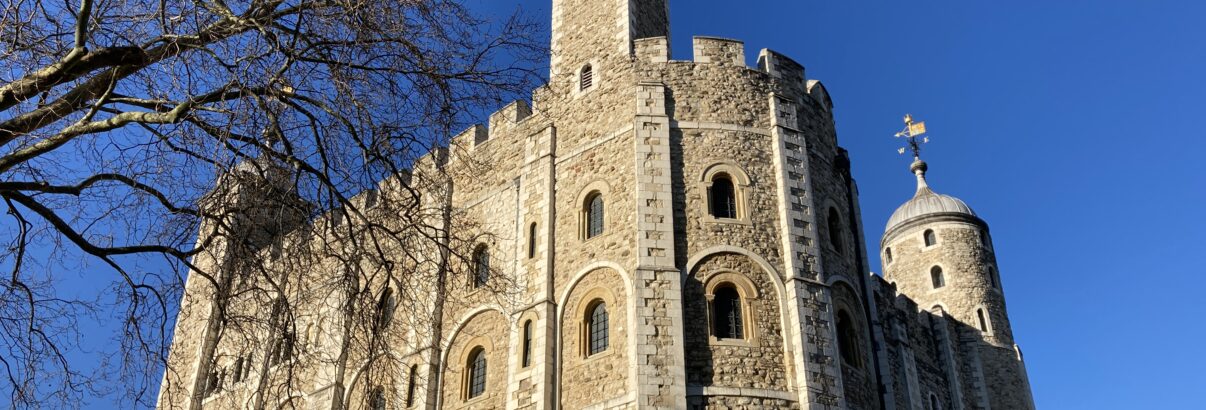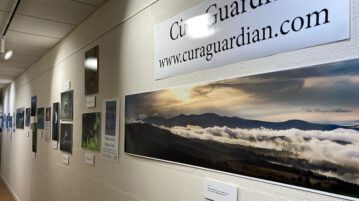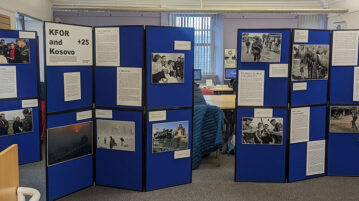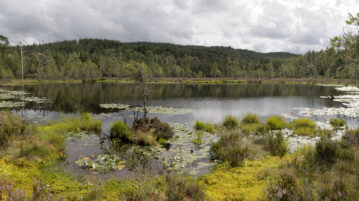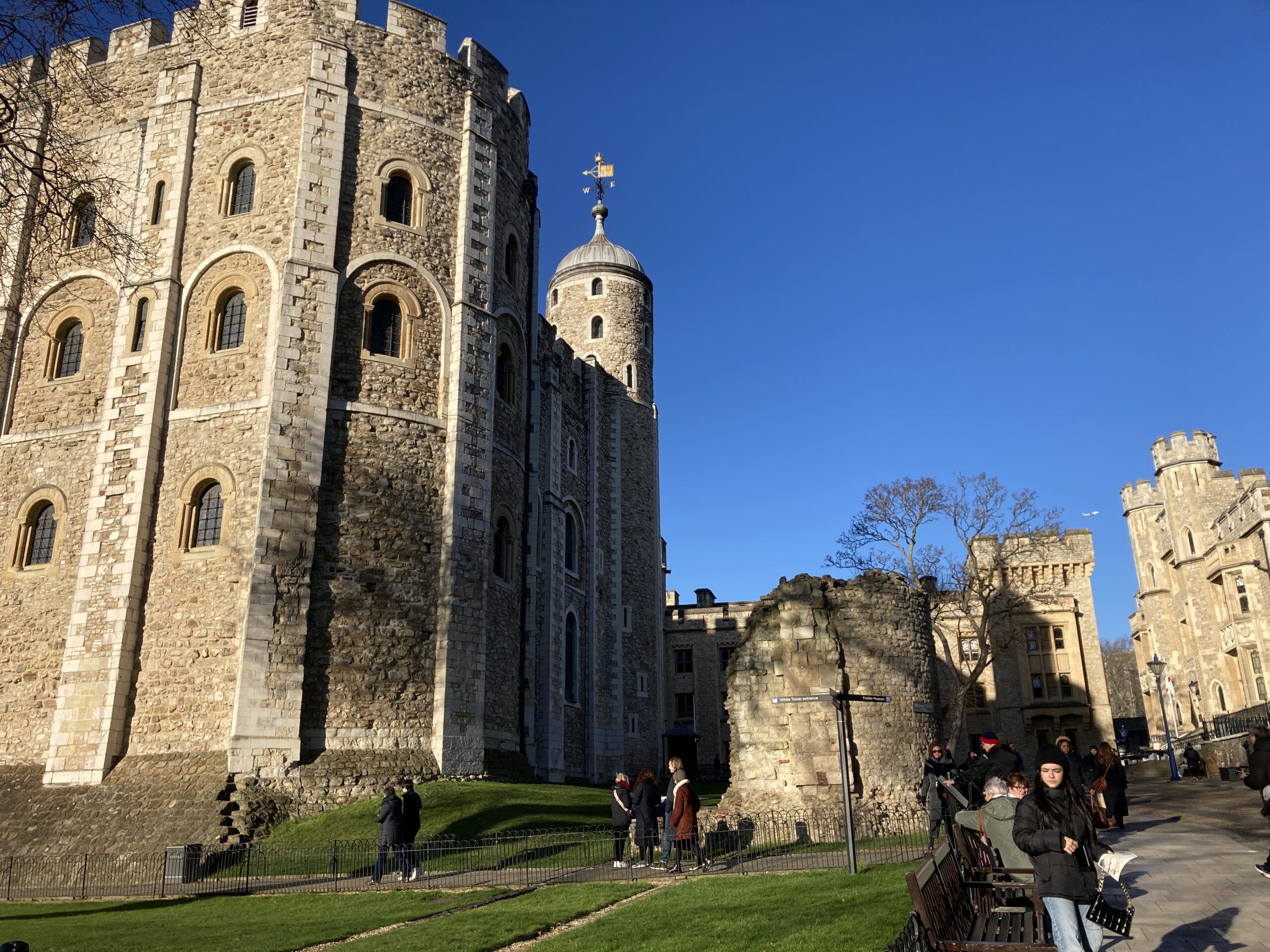
The launch of the first part of the ‘KFOR and Kosovo +25’ exhibition took place at the magnificent historic location of the Tower of London Fusilier Museum, pictured above, on Monday, January 15th with a distinguished audience of special guests who had come together for this important occasion.
The Fusilier Museum houses the Royal Regiment of Fusiliers’ Regimental Headquarters. The Royal Regiment of Fusiliers was formed on 20th June 1685, when King James II issued a Royal Warrant to raise an infantry force from the existing Tower of London Garrison. The first Commanding Officer was the Constable of the Tower. The Fusiliers’ intended role was to guard the guns at the Tower of London. The force later fought in Belgium and Spain, and several other conflicts including the American War of Independence and the First World War The regiment are one of the main regiments featured in the Heartstone ‘KFOR and Kosovo +25’ photodocumentary and the invitation to stage this exhibition at this historic location came from them. The exhibition was presented in partnership with the regiment.
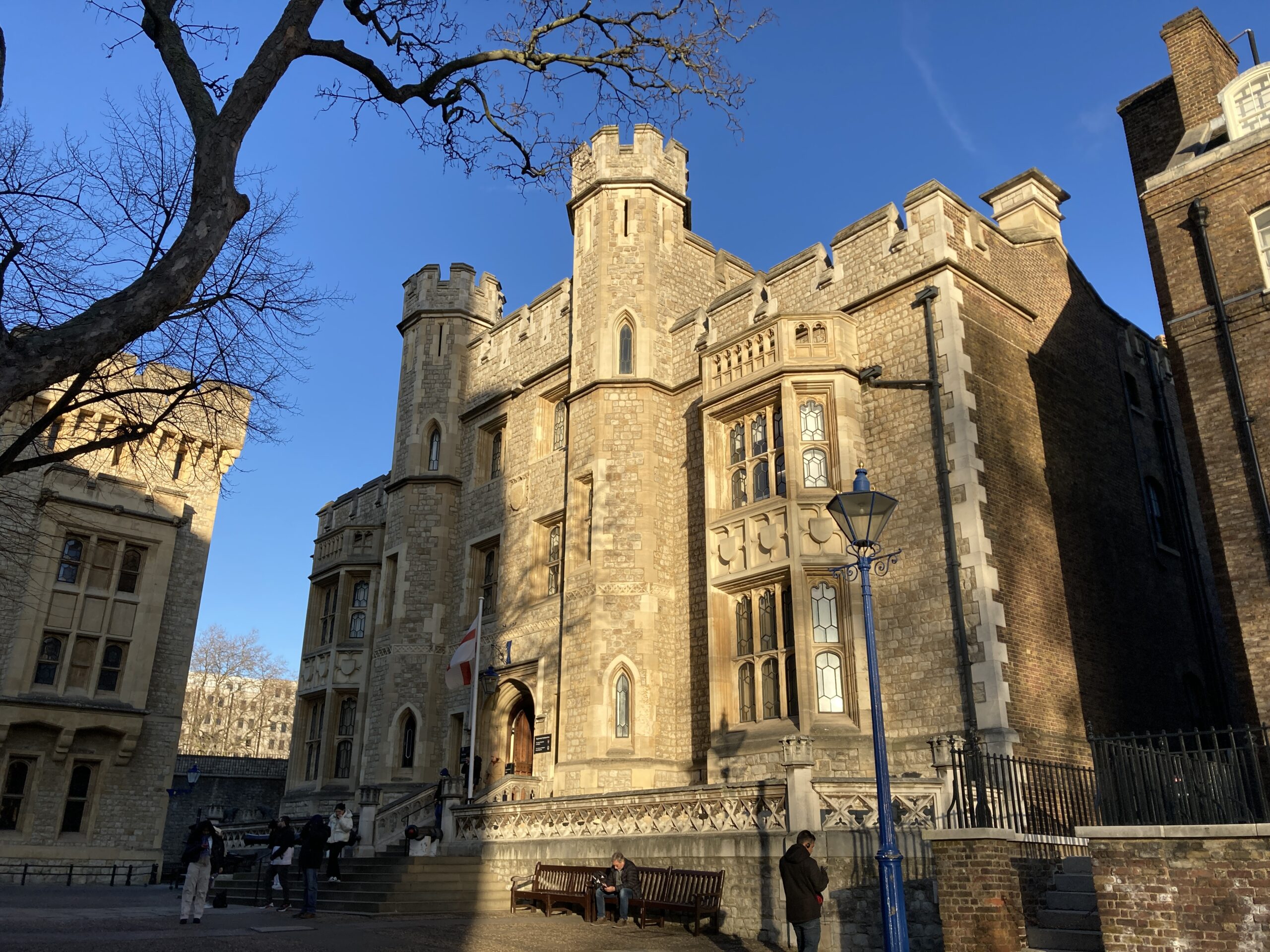
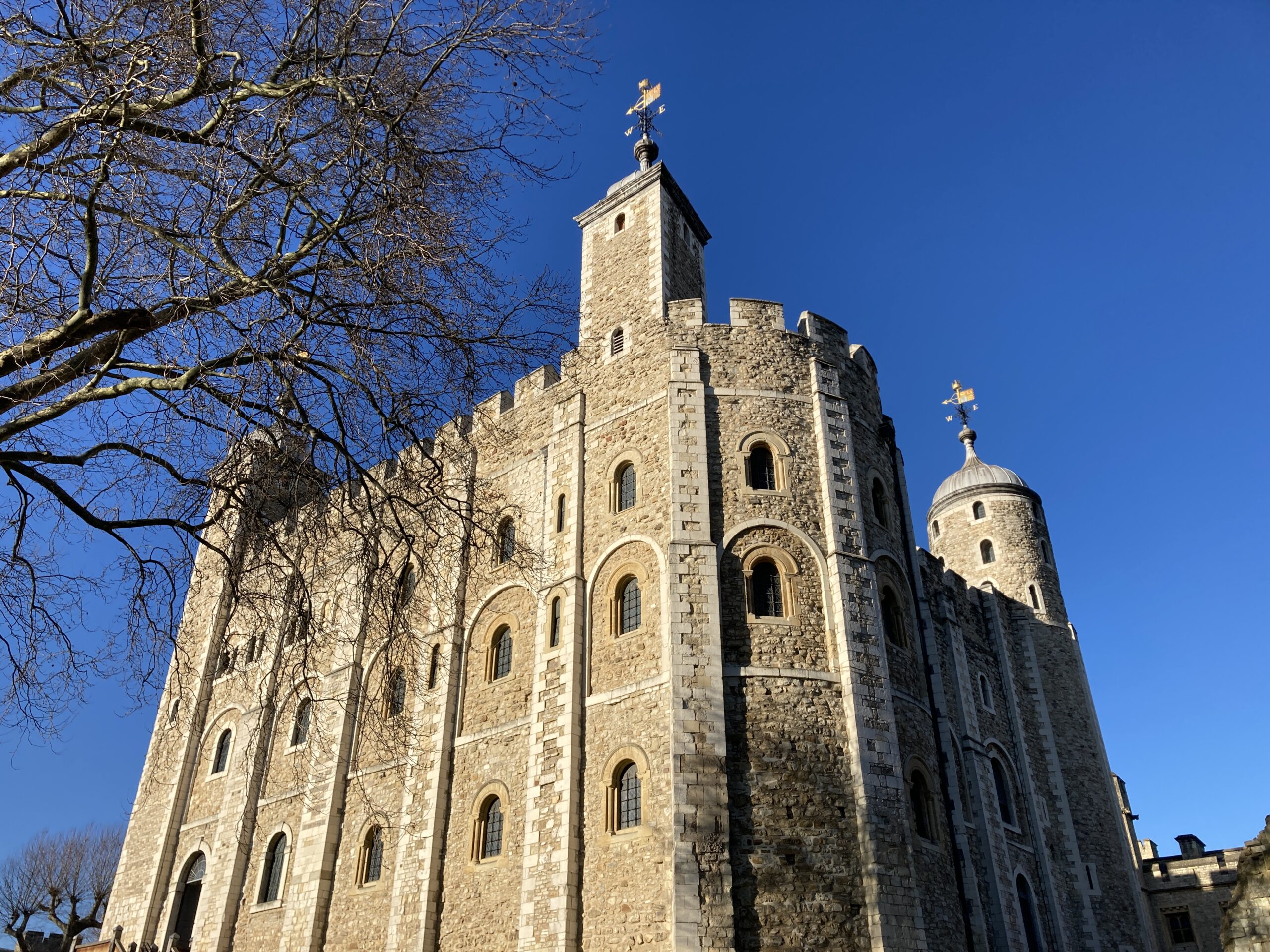
The launch event included special guests Lord George Robertson, NATO Secretary General at the time of the photodocumentary and assisting with all aspects of this current staging, Lord David Hannay – Chair, UN All Party Parliamentary Group, Mr Martin Vickers, MP – Prime Minister’s Special Envoy for the Western Balkans and Chair of the Kosovo APPG, Gen Sir Michael Jackson – commander of KFOR at the time of the photodocumentary who subsequently became Chief of the General Staff, Gen Sir Nicholas Carter – first Commanding Officer, 2nd Battalion Royal Green Jackets in Pristina in 1999 and Chief of the Defence Staff 2018-21, Kosovo Ambassador, HE Mr Ilir Kapiti and HM Ambassador to Kosovo, Mr Jonathan Hargreaves.
 Above front row right to left – Lord Robertson, Gen Sir Mike Jackson, HE Ambassador Mr Ilir Kapiti, HM Ambassador to Kosovo, Jonathan Hargreaves, Lord David Hannay, Mr Leslie Morgan – Deputy Lieutenant for Tower Hamlets, Cllr Abu Talha Chowdhury, Cabinet Member for Tower Hamlets
Above front row right to left – Lord Robertson, Gen Sir Mike Jackson, HE Ambassador Mr Ilir Kapiti, HM Ambassador to Kosovo, Jonathan Hargreaves, Lord David Hannay, Mr Leslie Morgan – Deputy Lieutenant for Tower Hamlets, Cllr Abu Talha Chowdhury, Cabinet Member for Tower Hamlets
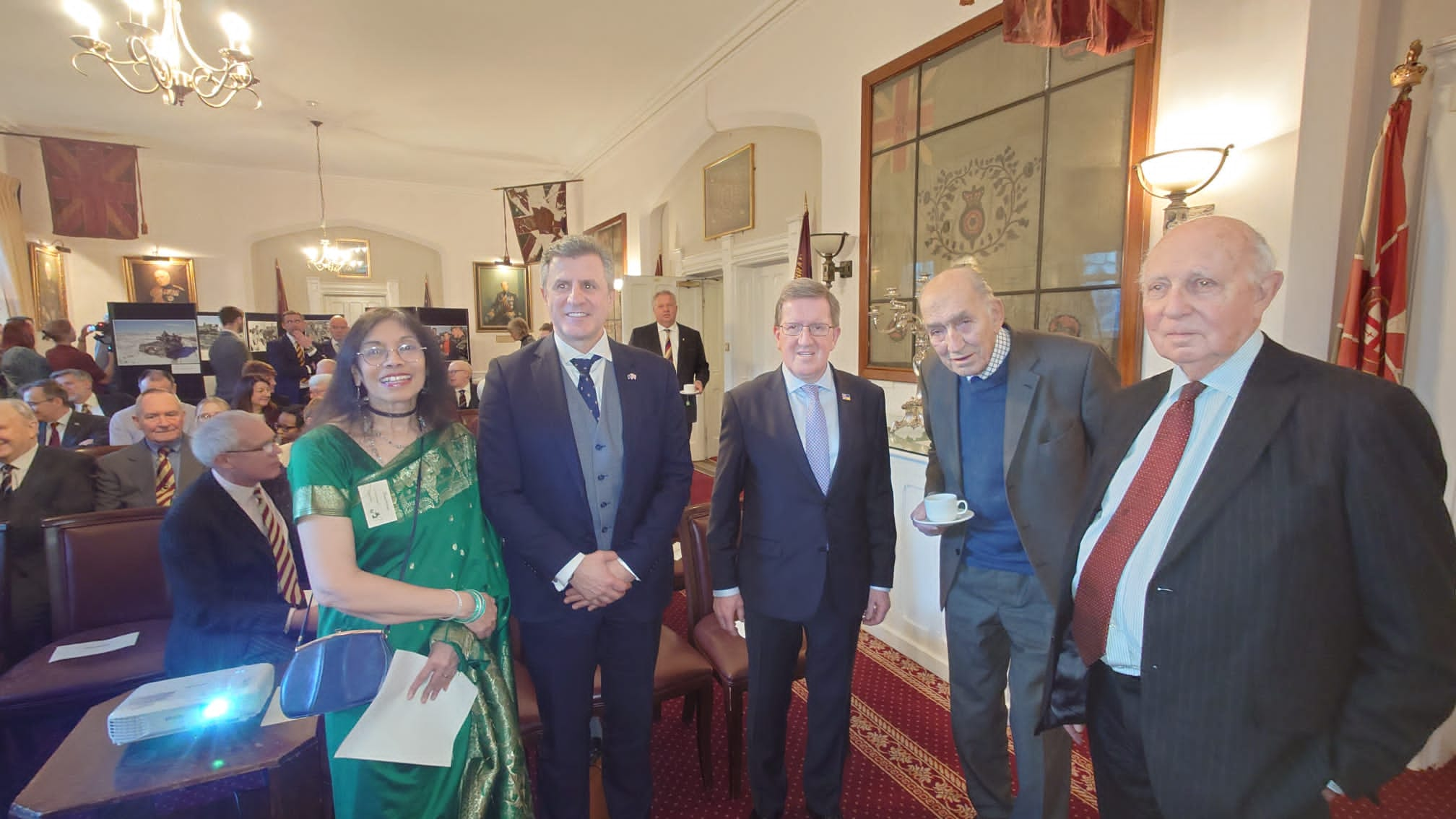 Above: left to right – Sitakumari, HE Mr Ilir Kapiti – Kosovo Ambassador to the UK, Lord George Robertson, Gen Sir Mike Jackson, Lord David Hannay who all spoke at the event.
Above: left to right – Sitakumari, HE Mr Ilir Kapiti – Kosovo Ambassador to the UK, Lord George Robertson, Gen Sir Mike Jackson, Lord David Hannay who all spoke at the event.
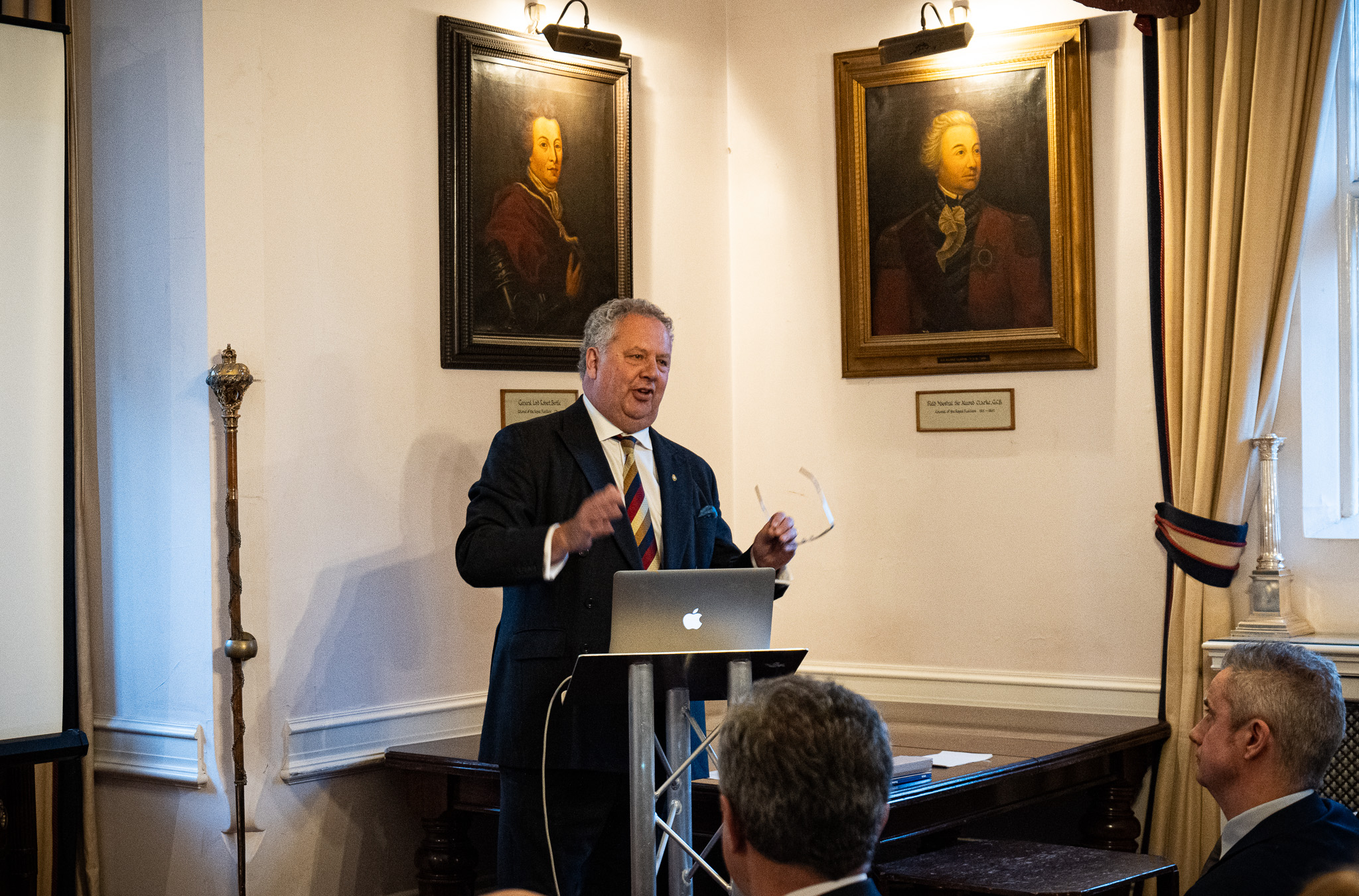
Left: Col (retd) Simon Diggins, Chair of the Museum welcomed assembled guests and Col (retd) J W Denny, MBE, spoke on behalf of the regiment and the role of the Museum today as well as in the past.
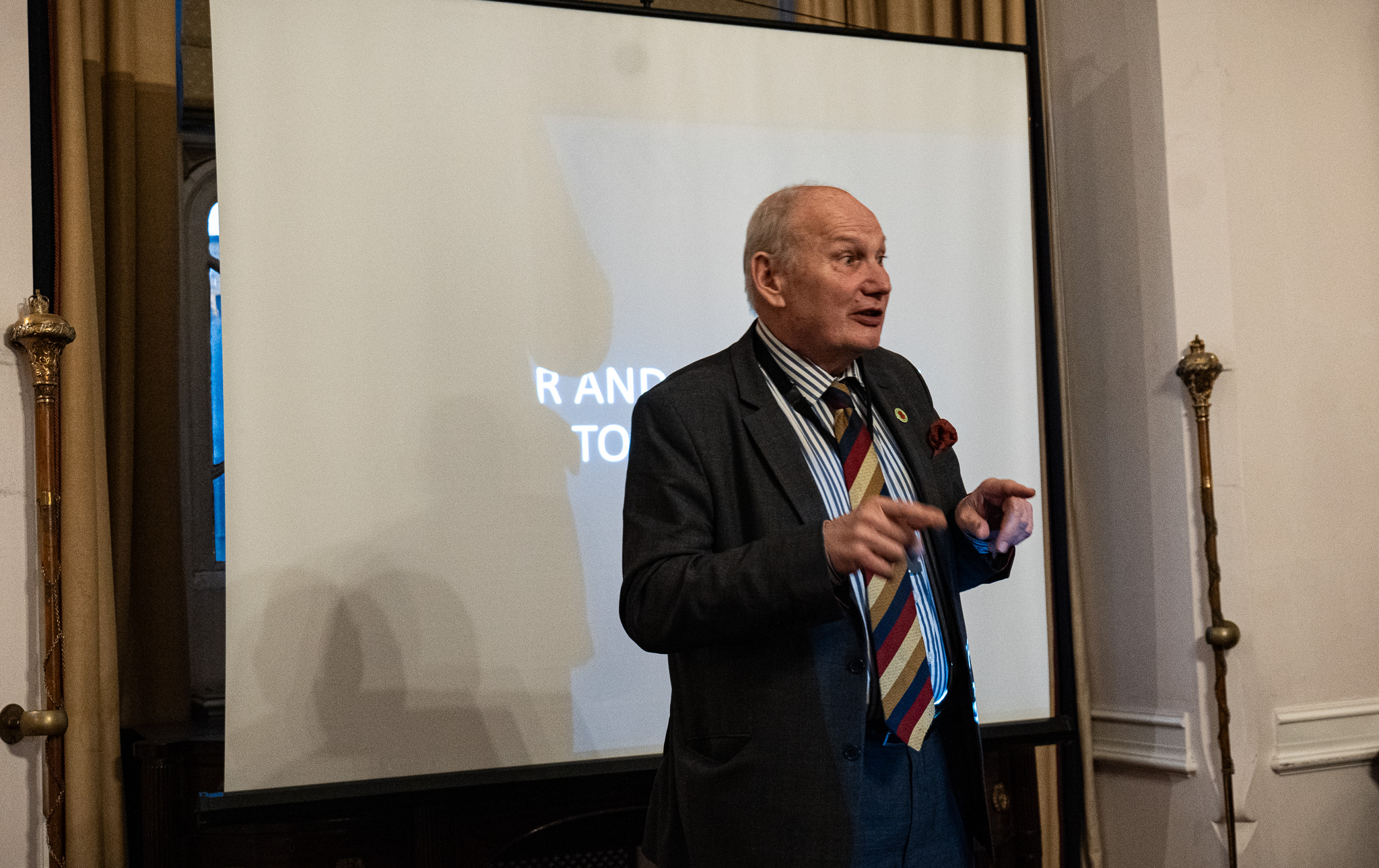
Left: Col (retd) James W Denny MBE Regimental Secretary, The Royal Regiment of Fusiliers (at left), spoke for the regiment, presenting something of its history and the value of hosting this exhibition at this time, working with Heartstone and helping to locate the soldiers featured in the images.
Col (retd) James W Denny said:
‘It was both a pleasure and privilege to work in collaboration with Heartstone on the ‘KFOR and Kosovo +25’ project especially as it is a such a thought-provoking and well researched exhibition which succeeds in providing a greater understanding about the difficulties the world faced 25 years ago and continues to face today. I believe that this exhibition has an essential part to play in the education of young people. I would encourage schools and colleges to view the exhibition.
Regimentally the mission in Kosovo was demanding and required the best of skills from the Fusiliers. Peacekeeping is not easy and requires patience, tact and diplomacy but also to know when there is a requirement to be more robust. The photo exhibition and the stories, as told by those in the photos, proves this.’
Left: Cllr Abu Talha Chowdhury , Cabinet Member, Tower Hamlets Borough Council, the borough in which the Tower of London sits, spoke of the importance and relevance of the exhibition for all communities, including his own Bangladeshi community and how he is assisting with taking the exhibition and its linked project out to reach grassroots communities.
, Cabinet Member, Tower Hamlets Borough Council, the borough in which the Tower of London sits, spoke of the importance and relevance of the exhibition for all communities, including his own Bangladeshi community and how he is assisting with taking the exhibition and its linked project out to reach grassroots communities.
Also present were representatives of UNA London, Interfaith Network in London and veterans organisations who are supporting this initiative. Sitakumari, Director of Heartstone, who organised the original access, presented the background to the story, how it was gathered and its role at the time and how it is being used today. An unexpected additional highly distinguished guest speaker was Gen Sir Mike Jackson.
This initiative is centred on a special access Heartstone photodocumentary produced in Kosovo in 2000-1 by Heartstone’s photojournalist, Nick Sidle, at the start of the KFOR intervention. The first London staging of this new reworked exhibition was focussed on soldiers of the Royal Regiment of Fusiliers, one of the regiments featured in the original photodocumentary, hence the invitation to stage this at the Fusilier Museum in partnership with the regiment.
The Background to the Photodocumentary
In 1999, KFOR, the NATO led international peacekeeping force, entered Kosovo following resolution 1244 by the United Nations Security Council. 2024 marks the 25th anniversary of that deployment. The first UN Security Council Resolution connected to Kosovo was passed on 31st March 1998 and the second on the 23rd September 1998. This was followed by a series of resolutions culminating in Resolution 1244 one year later.
Documentary photographer Nick Sidle, was attached to KFOR in the operation’s early stages. He was embedded with several units and produced a unique record of the work of the peacekeepers showing troops from nine different countries including nineteen individual regiments or units from the United Kingdom and the United States, the two largest contributors to KFOR. The photostory captured not just the work of the soldiers, it also highlighted the world of Kosovo at the time from a human angle, to enable audiences beyond the country to empathise and understand a world in which intolerance and hate had been taken to new levels and why there was a need for the peacekeeping intervention to safeguard lives and homes in a setting where violent retaliation was a reality, and help rebuild ordinary life in what were exceptional circumstances. The ‘KFOR and Kosovo’ exhibition in 2002 was presented UK-wide, at the Brussels European Parliament and NATO HQ. It was also converted into a format for use by schools and colleges nationwide to generate discussion on the issues raised.
25 years later, this story is not over. It is a documentary of a period of history that must not be forgotten, but it also holds many lessons for our time in a world where many are living with conflict/hostility, circumstances which are impacting on all of us. We must remember KFOR is still active in Kosovo. The photostory, and the discussion it leads to, takes its audiences, through a visual, non-political, cultural medium, into a world where they can empathise with those of different backgrounds, understand the commonality of human experience, why prejudice/intolerance needs to be addressed at its earliest stages and particularly in times of difficulty, the need for peacekeeping forces and understand more clearly the refugee experience and that of displaced peoples. However, this is a positive story – it is about human resilience and hope in extraordinarily difficult circumstances and the importance of people and nations working co-operatively together to achieve positive outcomes.
This exhibition is being reworked to be presented in its full form towards the end of this year and in advance of that, this was the first staging in England following its presentation at the Scottish Parliament on September 19th 2023.
The launch event included veterans of the Fusiliers, who were in Kosovo at the time of the photodocumentary and featured in the images, who have been tracked down for the purpose of adding their stories, now 25 years later, into the new exhibition. This exhibition therefore provides a mechanism to not just keep alive powerful memories and experiences but also to use this story to inspire and inform the next generation.
The exhibition, the launch and the events linked to it over the subsequent days for the general public and schools groups were all very successful. This included a powerful and insightful presentation from Dr Jennifer Jackson-Preece, Associate Professor at the London School of Economics, whose special area of study and expertise is the Balkans, its long history and situation today and Paul Davies, one of the veterans from the images, who brought to life what was happening, the impact at the time for the ordinary civilians he had contact with and how the experience has shaped his life into the current time.
Images from the Exhibition
The photodocumentary was gathered over the course of 1 year in 2000-1 when Nick Sidle was attached to several different regiments from the UK who were part of KFOR. The images presented in this exhibition were mostly drawn from that part of the assignment although other regiments and nations were included to give a complete picture.


Left: Images included showed soldiers interacting with all sectors of the Kosovo community, providing security for children going to school, ordinary people going to work, outside churches and mosques and other everyday settings.

Right: Images included Billy Miller, one of the soldiers who has been located by the regiment and who has been interviewed for the exhibition. He took charge of developing a football team with the young men, drawn from all communities. Football was used as a tool to bring the communities together without hostility and conflict. He is also pictured looking at a map with a farmer who has to identify the location of landmines before he can plant his crops.
Images also included Drew Gibson, another veteran located and interviewed for the exhibition and who was present at the launch event.
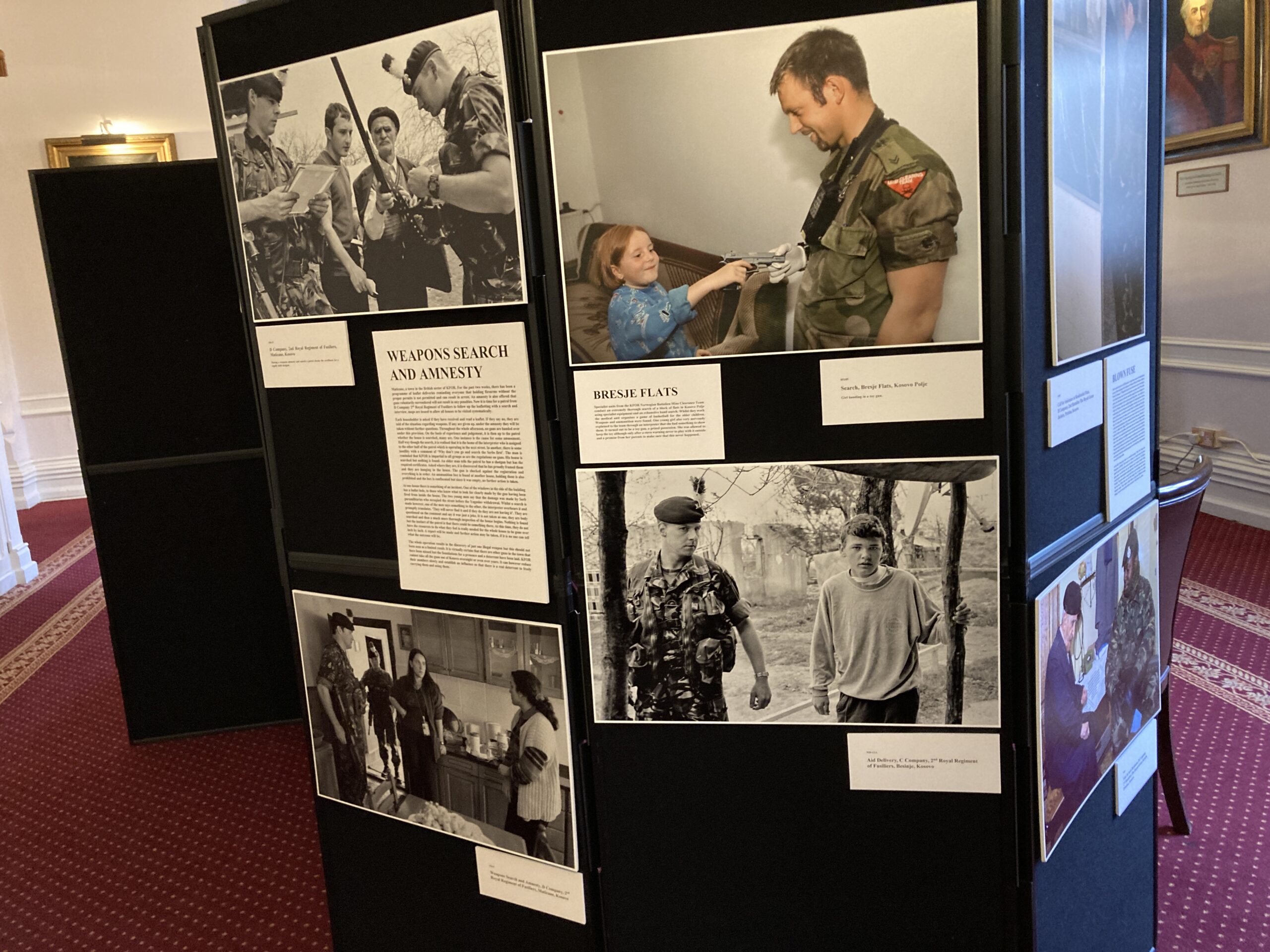
Left: One section of the exhibition covered what happened during the weapons amnesty during which time homes were searched and illegal weapons were handed in. This required diplomatic contact with all communities. A child is pictured handing in her toy gun, an old man is seen with a certificate for his rifle.
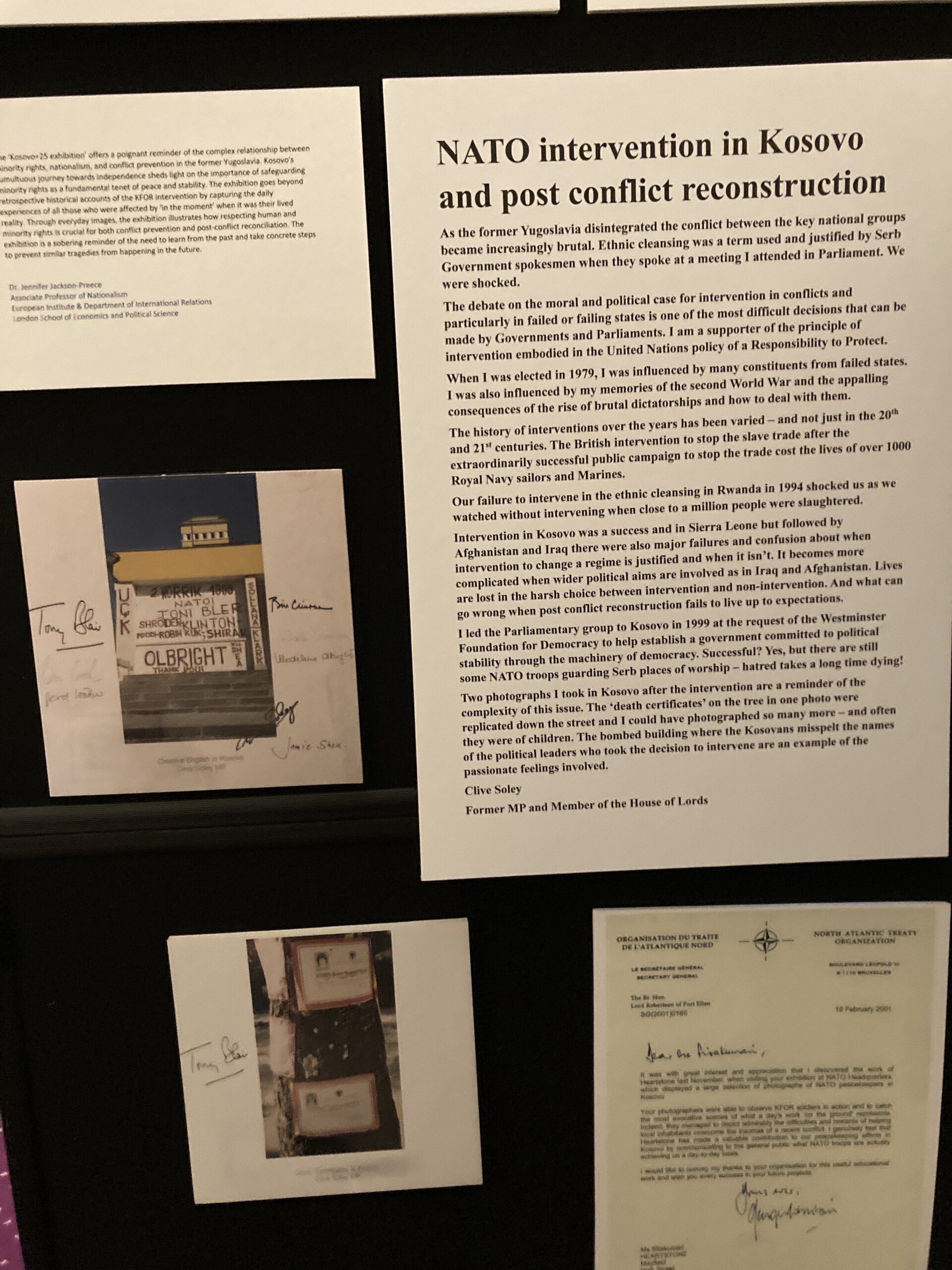
Left: One of the panels was produced by Lord Clive Soley. The images of signatures from Prime Minister Tony Blair and President Bill Clinton are photographs taken by him which he secured from them 25 years ago. Lord Soley is now assisting with new presentations of this exhibition in the UK. Lord Robertson has secured the agreement of both Sir Tony Blair and President Bill Clinton to sign copies of the book of this exhibition, with presentation copies going to three proposed special sites – the Library of Congress in the USA, the British Library in London and the Kosovo National Library. This will take shape at the first presentation of the full-scale exhibition in the autumn of 2024.

Above from left: Col (retd) James Denny, Sitakumari, Drew Gibson – one of the original soldiers featured in the images who has been located by the regiment, Master of the Fletchers Charity, one of the sponsors of the Fusilier Museum exhibition.
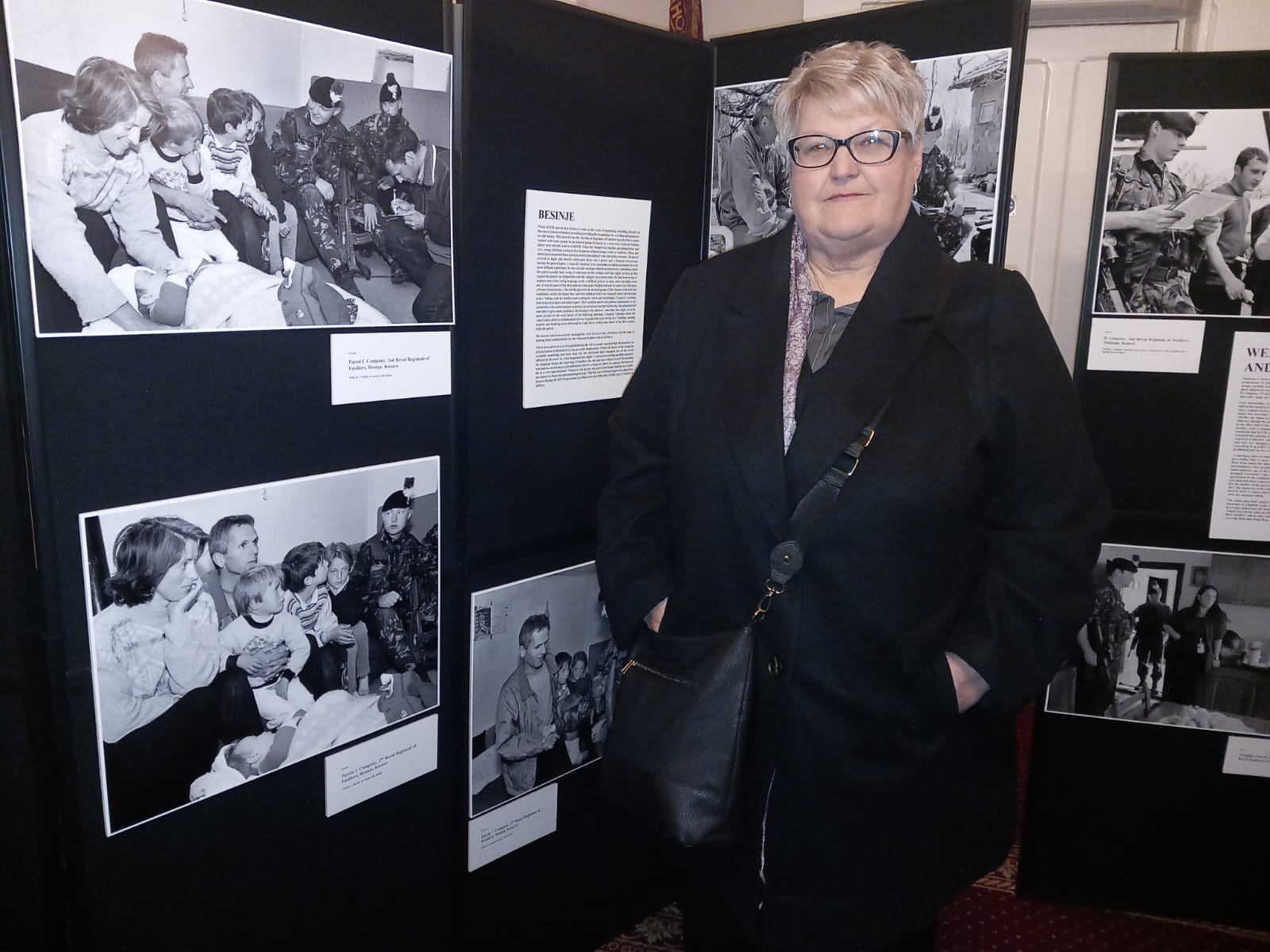
Left: Ms Carol Valentine, mother of Simon Valentine pictured in the images. She represented him at the event as a special guest as Simon was tragically killed whilst on deployment in Afghanistan a few years later. She has become a strong supporter of this exhibition and actively assisting with all presentations/promotion of the exhibition.
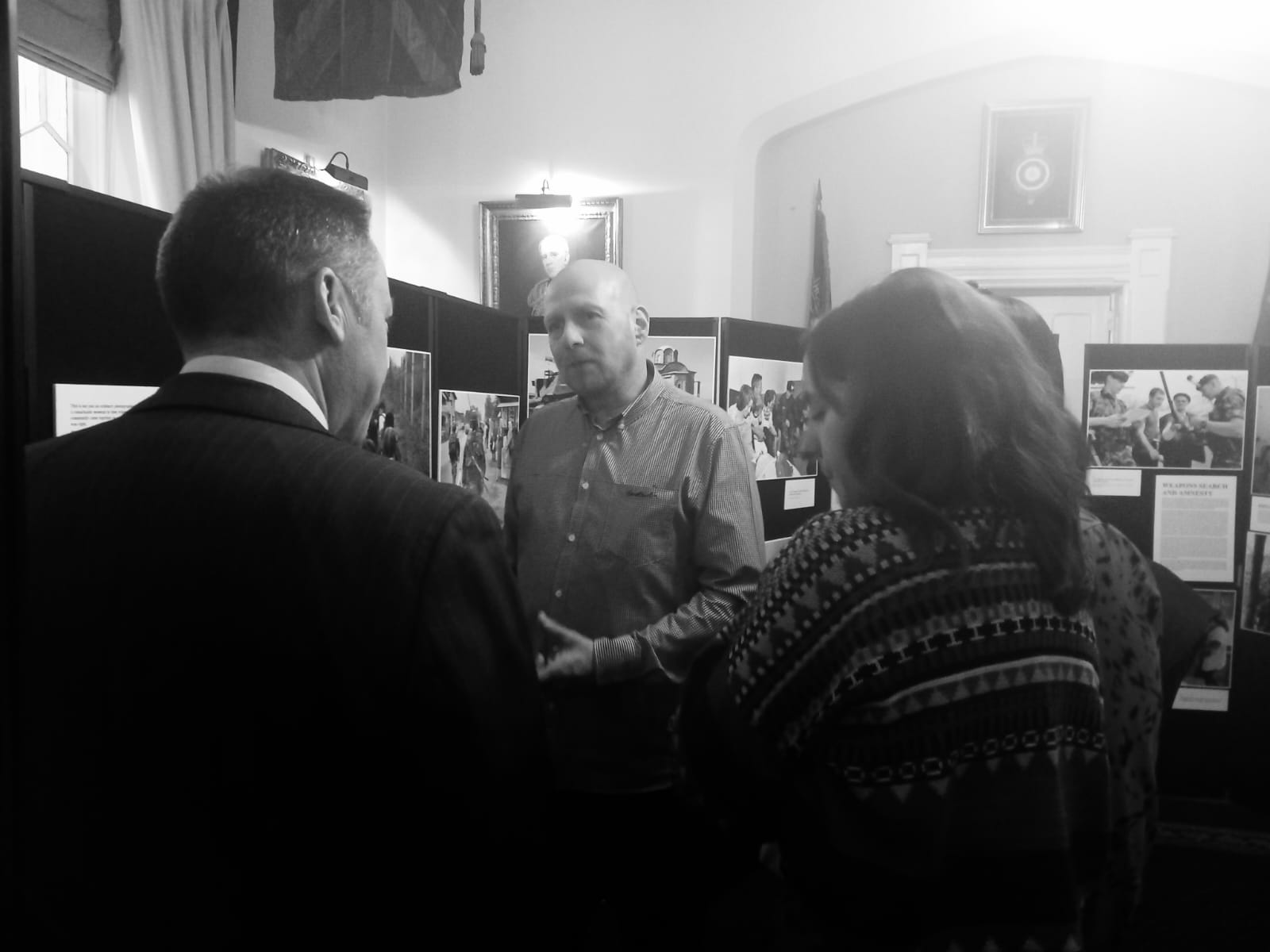
Right: Paul Davies, featured in the images behind him, one of the veterans who has been located to be part of the new exhibition.
He said: ‘I am very proud to have been part of the photodocumentary and exhibition and part of history! I never thought I would be….’

Left: Col (retd) Simon Diggins, OBE, Chair of the Fusilier Museum who welcomed all to the launch and provided a brief history of the Museum. Pictured here with Sitakumari.
Col (retd) Simon Diggins said:
‘The Kosovo Campaign of 1999 was conducted to stop a clear and immediate threat to the Kosovan population from the worst excesses of a virulent form of Serb nationalism: at one point, it was estimated that nearly 90% of the population was displaced. Following a NATO air campaign, the Fusiliers were amongst the first troops into that country, providing much needed stability and protection to a traumatised people. They encountered horrors and hostility but also moments of almost sublime humanity, across religious and ethnic divides: this exhibition captures it all.
The Fusiliers Museum London were delighted and honoured when Heartstone asked us to launch the exhibition in England. For us, like so many other museums and cultural institutions, we are examining our core purposes and how and what we display. With William Faulkner, we believe that, “The past is not dead; it is not even past.” Kosovo is now a stable country but shadows of the old conflict remain. This wonderful exhibition helps all of us to remember but also to learn and, in era when inter-ethnic conflicts have again raised their head, that learning is ever more urgent.’
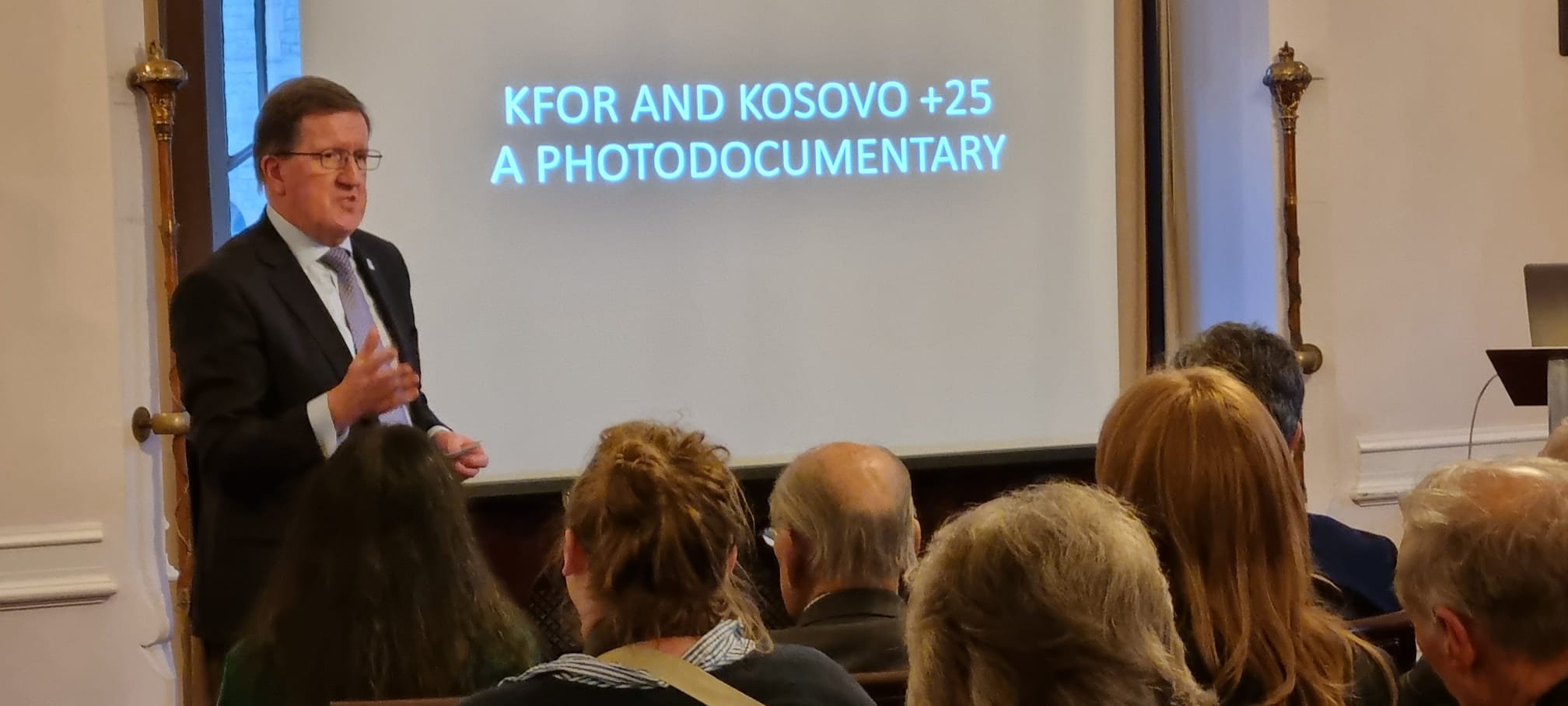 Above: Lord Robertson opened the event.
Above: Lord Robertson opened the event.
Lord Robertson said:
‘This is not just an ordinary photographic/documentary exhibition. It is a reminder of a remarkable moment in time when good defeated evil, when the international community came together to stop a near genocide and where we took a stand for what was right. We said then clearly and concisely ‘Milosevic forces out, NATO in, refugees home’. We did all three and I was privileged only a few weeks ago to visit Pristina and while there to walk safely and peacefully in the streets among free people. All because we took controversial action 24 years ago.
As we face Russia’s aggression today in Ukraine it is worth reminding ourselves that had we not acted militarily and politically in 1999 Kosovo would today have no Kosovar Albanians and, forced from their homes, they would be globally scattered as permanent refugees.
Today, not everything in Kosovo may be like Switzerland but its people are free, not persecuted and alive while carving out a new European nation.
These photos, and the people in them represent a marvellous moment in my life and in the lives of so many others who are alive today – as well as in the life of the many thousands of military personnel who served to save Kosovo.
These troops, whose numbers included Russians as well, made a huge difference to the future of the Balkans and can share the credit for a humanitarian success story. They saved thousands of lives and let a nation and its people build a prosperous future.
I am so proud to have helped in a small way with this project.’
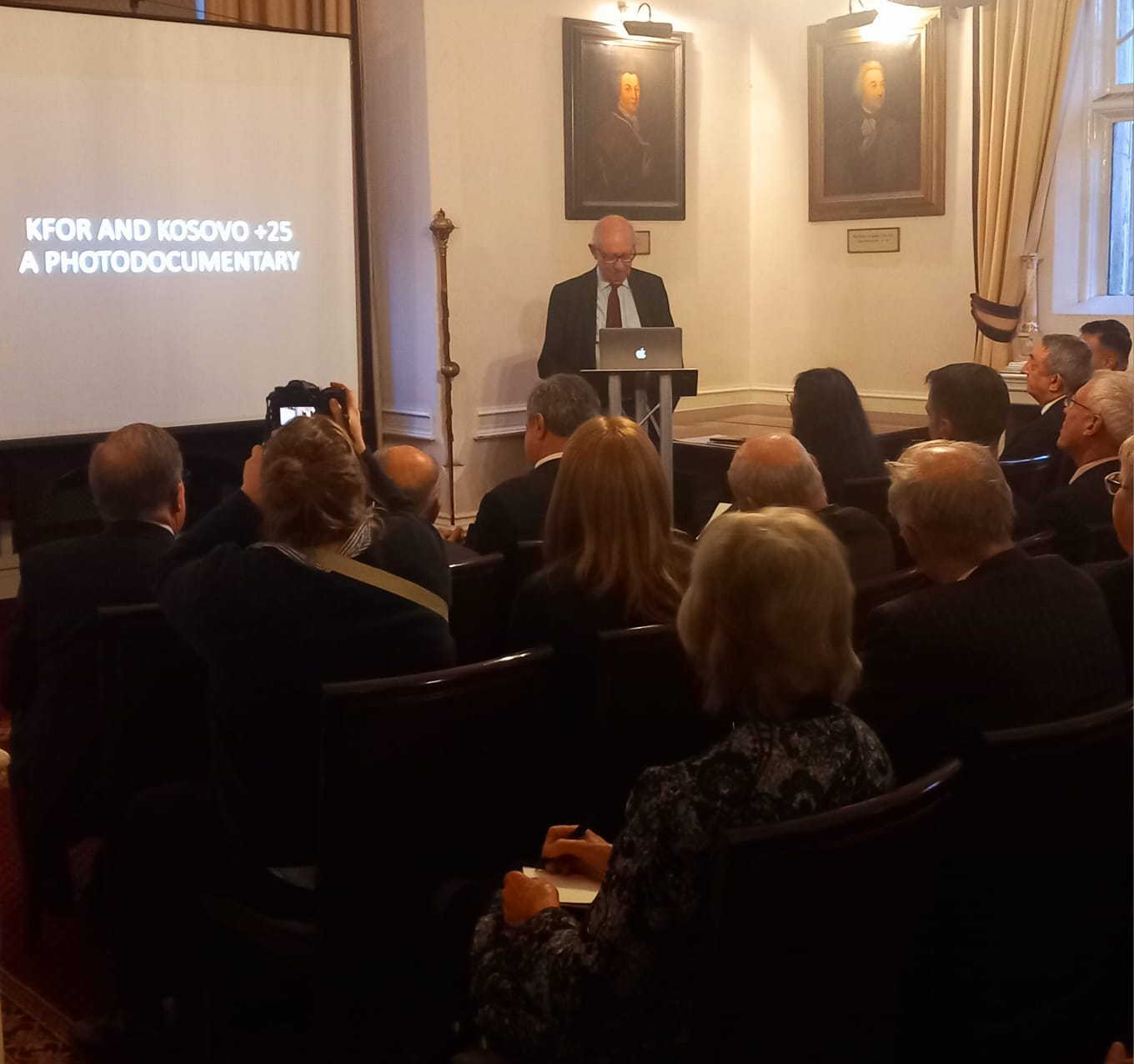
Left: Lord David Hannay, Chair of the All Party Parliamentary Group for the UN, followed Lord Robertson and spoke of the important role of the UN in the Kosovo campaign and its continued role today, particularly in the context of peacekeeping.
Lord Hannay said:
‘This photo exhibition of the 25th anniversary of the Fusiliers’ peacekeeping deployment in Kosovo is a brilliant initiative . The photos really capture just what Kosovo was like when the peacekeepers arrived – a people traumatised by multiple human rights abuses and rescued from ethnic cleansing and worse . And they show too how individual Fusiliers brought sympathy and relief to ordinary Kosovars . Peacekeeping can sometimes seem a rather thankless task – overlooked if all goes well and with blame being piled on the peacekeepers when it does not . But it should not be . It is an essential part of a 21st century military career . And no one did it better than the Fusiliers and the other regiments featured in this exhibition in Kosovo in 2000 ….’
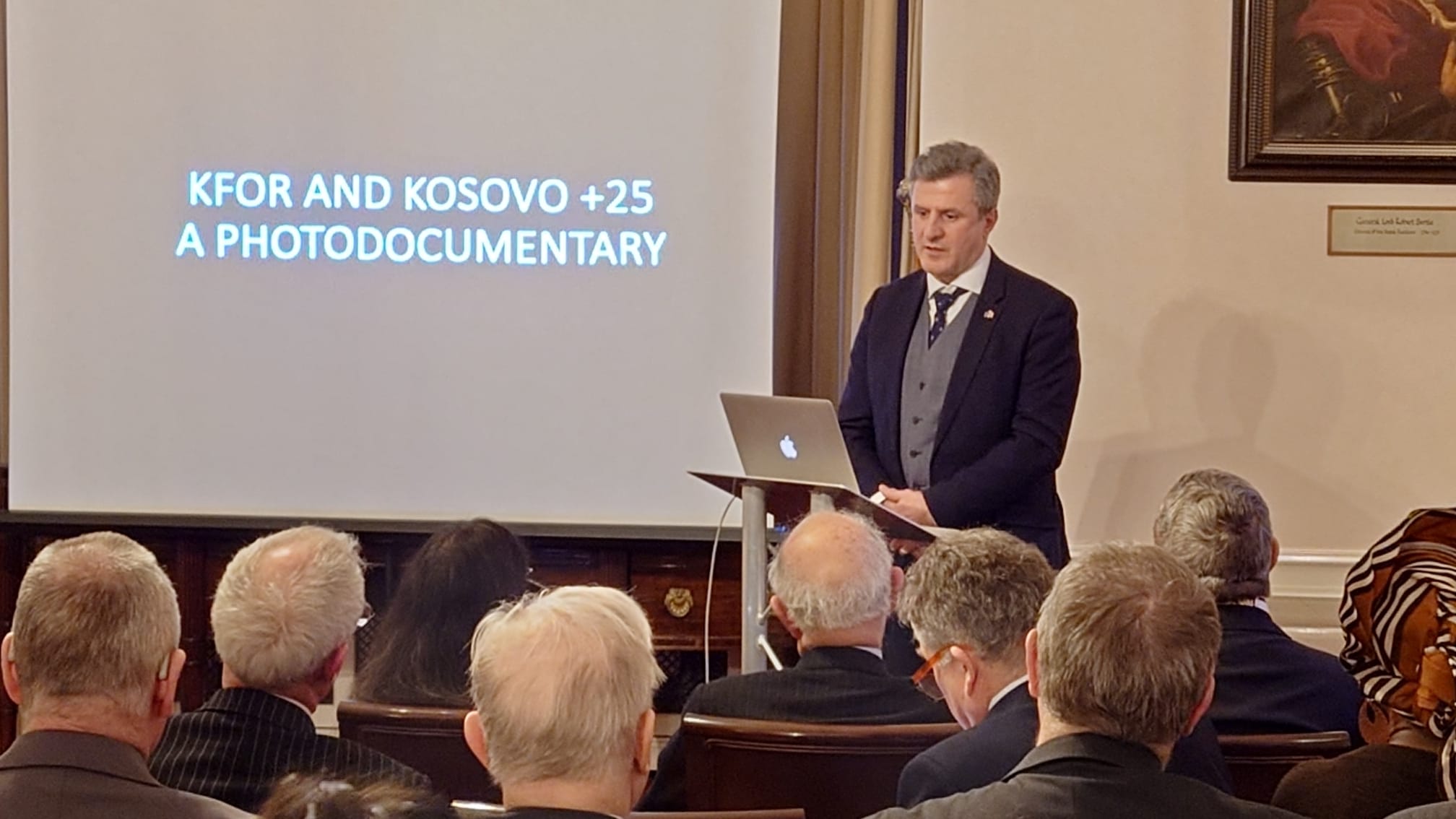
Left:HE Mr Ilir Kapiti, Kosovo Ambassador to the UK
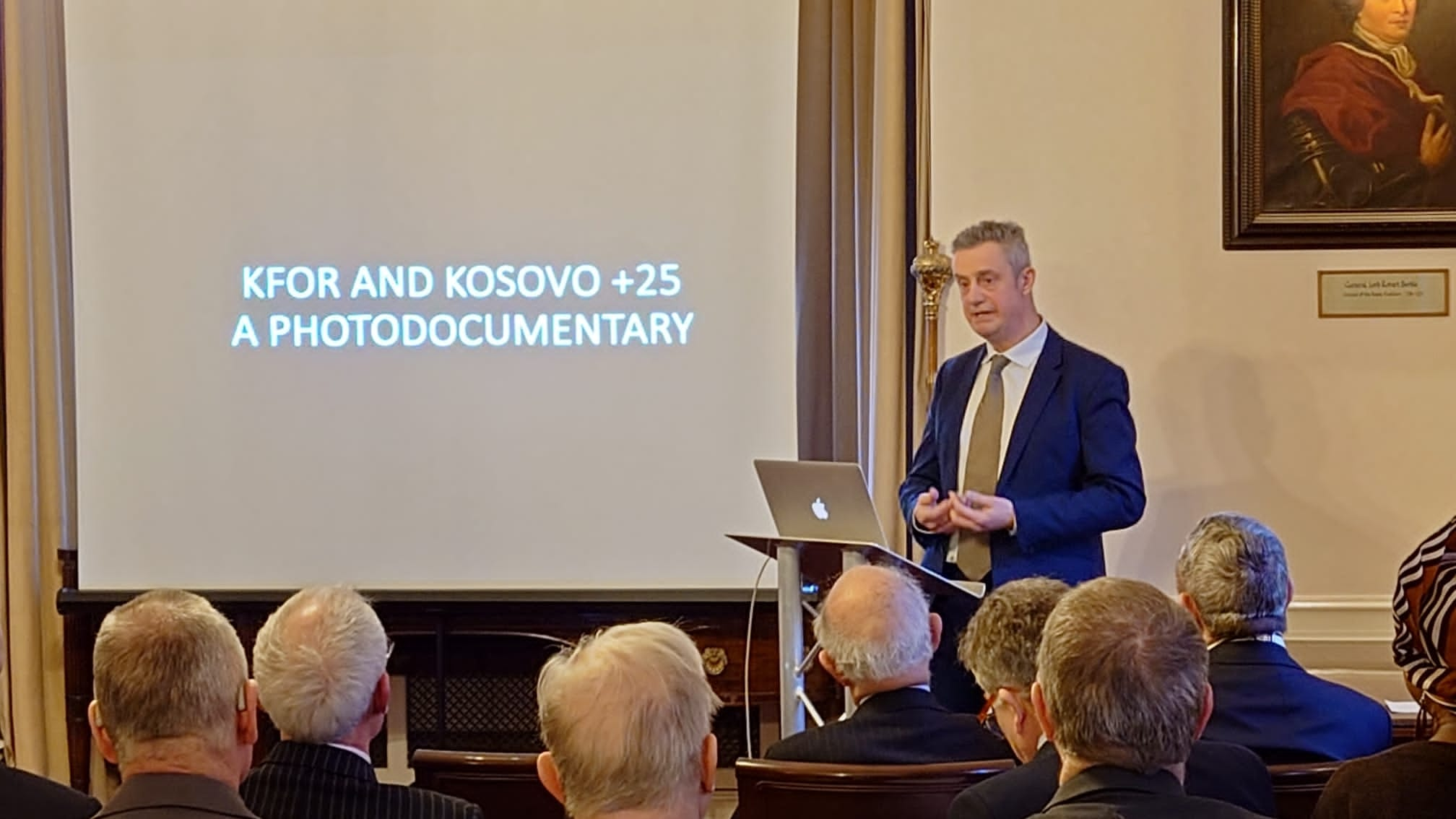
Left: HM Ambassador to Kosovo, Mr Jonathan Hargreaves, who is assisting with staging in Kosovo.
General Sir Mike Jackson, pictured below, presented the story of his famous encounter with the Russians and how he established a working relationship with the Russian general commanding the detachment at Pristina, providing the Russians with the protection of a squad of British soldiers, commanded by his son, Mark. This was a powerful demonstration of a human story, that despite differences, this could happen by individuals coming together, which is the message of Heartstone and the photodocumentary.

 Above: Sitakumari with Gen Sir Nick Carter who also spoke at the event.
Above: Sitakumari with Gen Sir Nick Carter who also spoke at the event.
Gen Sir Nick Carter said:
‘I am very pleased to be associated with this exhibition. As the Commanding Officer of 2nd Royal Green Jackets based in Pristina at the time it commemorates, I have very special memories of Kosovo and its people.
In a world where it is increasingly difficult to find international consensus on any geopolitical issue, Kosovo reminds us that it is possible for the international community to come together to help make headway towards a more positive outcome in a country riven by interethnic conflict.
Although sadly, despite much progress, Kosovo still has some way to go before its people are finally able to live together harmoniously.
Nick Sidle’s story resonates today, particularly given the ongoing conflicts in Ukraine and Israel. For it reminds us that the nature of war never changes. It is always about violent interaction between human beings, and it always brings great suffering.
His story brings to life in a clear and honest way the moment when – despite the darkest of times – the human spirit found a way of providing hope to shattered communities and restoring peace. It also brings to life the positive and neutral role that soldiers play as peacekeepers. A role that will continue to be needed in an ever more conflicted world.
Some of the soldiers who took part in the operation 25 years ago and who appear in the original images are part of this new reworked exhibition and here in person and their presence underlines the importance of commemorating those who strove to bring peace to Kosovo 25 years ago. Their efforts will not be forgotten, and their contribution will help educate the coming generation.
What could be more important in an ever more complex, dynamic, and unstable world.’
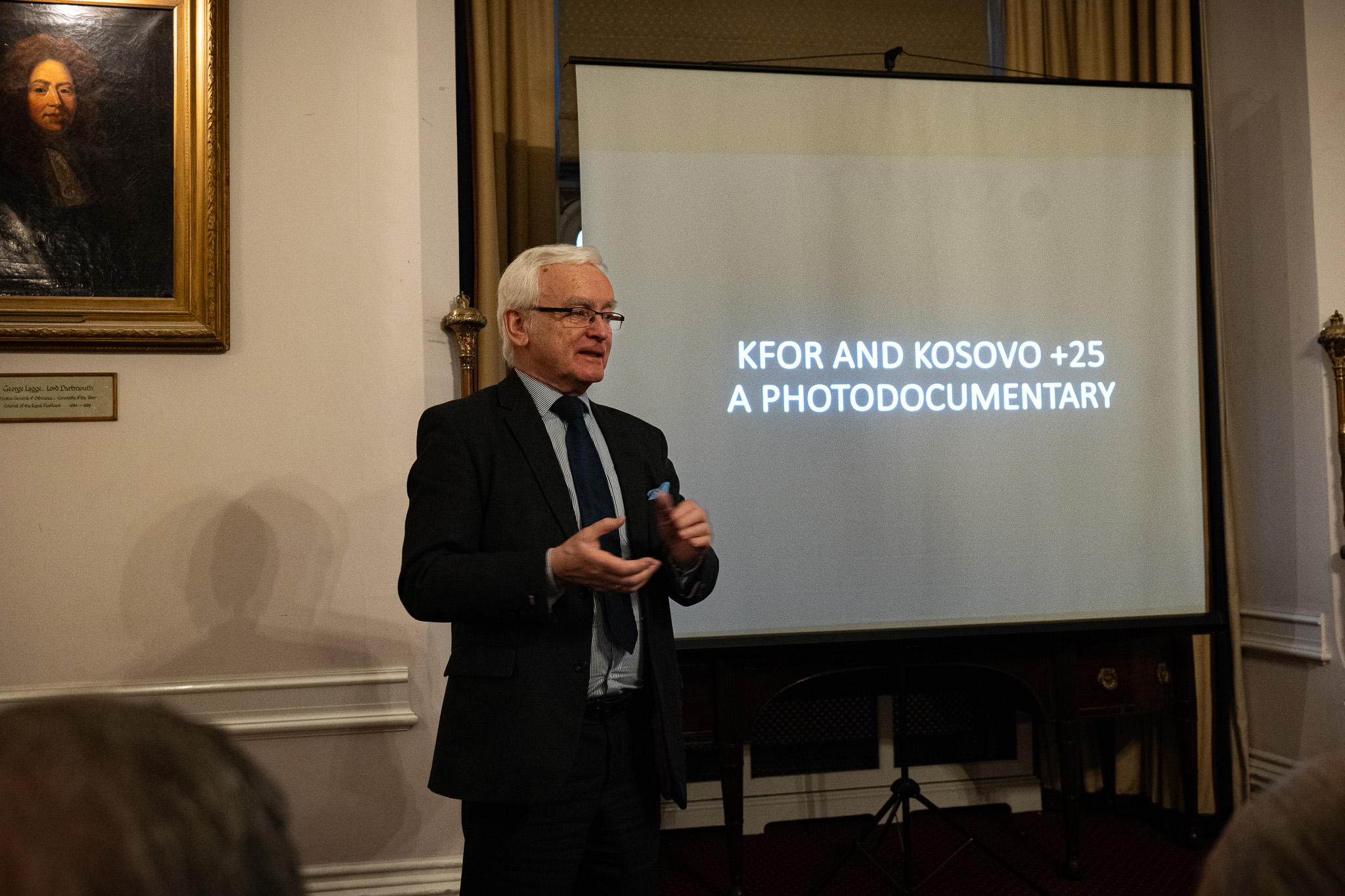 Above: Mr Martin Vickers, MP , spoke of the context in the past as presented in the exhibition and his own role today.
Above: Mr Martin Vickers, MP , spoke of the context in the past as presented in the exhibition and his own role today.
Mr Martin Vickers said:
‘The exhibition provided an excellent opportunity to educate those who are too young to have lived experience of the events of 25 years ago. It was also a poignant reminder for those of us who were around at the time to see difficult scenes of armed conflict and the pivotal role of the UN peacekeepers.
As both the Chair of the All-Party Parliamentary Group for Kosovo and the Prime Minister’s Trade Envoy to the Western Balkans, I am delighted to support Heartstone in their efforts and wish them the very best as they take this forward.’
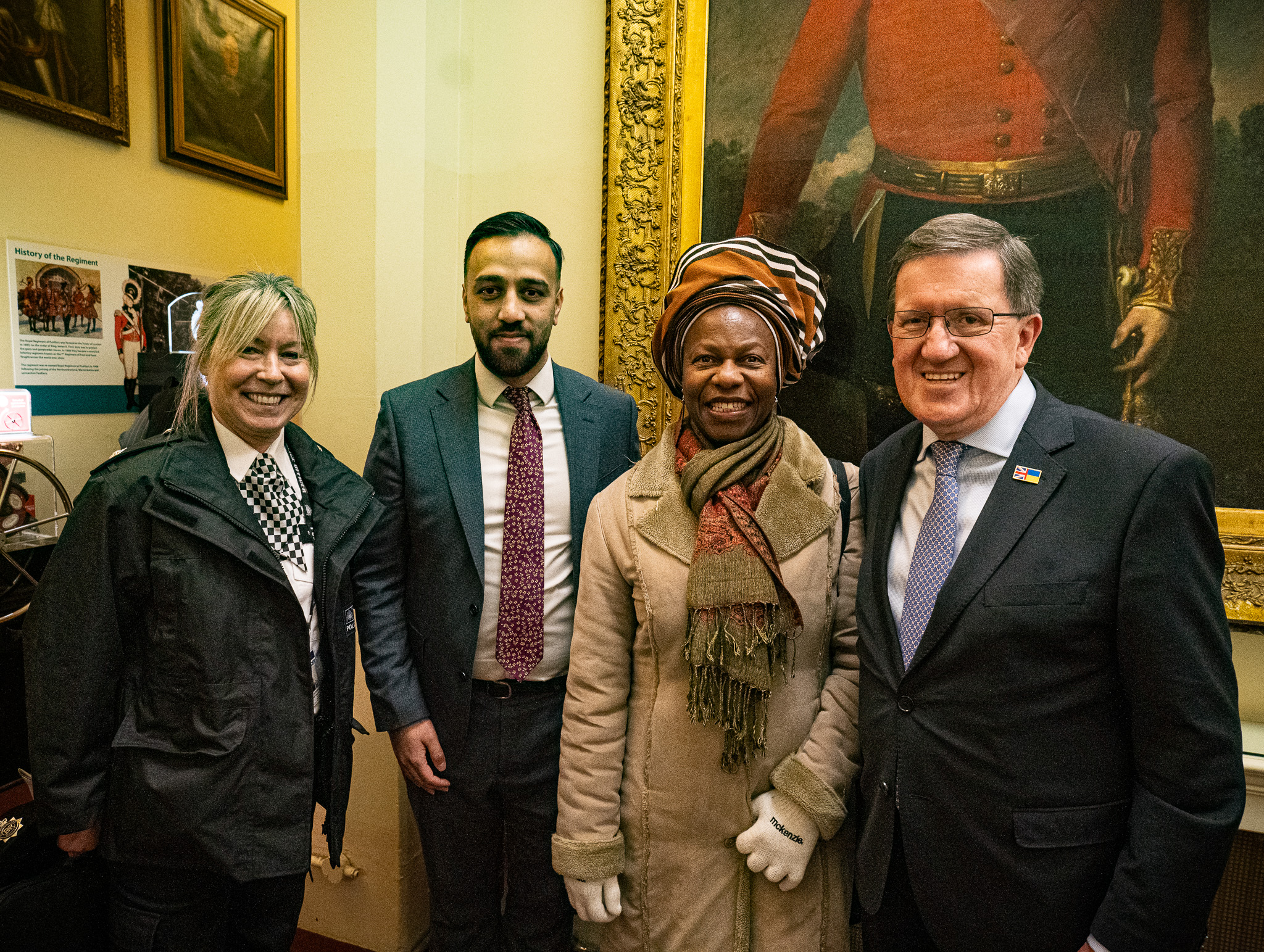 Above: Lord Robertson with Greenwich Cabinet Member, Cllr Ann-Marie Cousins, Tower Hamlets Cabinet Member, Cllr Abu Talha Chowdhury, and Supt Vicky Tunstall, Met Police. The London boroughs project which is using the ‘KFOR and Kosovo +25’ story to generate discussion/debate with young people is funded by the boroughs and MOPAC, part of the office of the Mayor of London
Above: Lord Robertson with Greenwich Cabinet Member, Cllr Ann-Marie Cousins, Tower Hamlets Cabinet Member, Cllr Abu Talha Chowdhury, and Supt Vicky Tunstall, Met Police. The London boroughs project which is using the ‘KFOR and Kosovo +25’ story to generate discussion/debate with young people is funded by the boroughs and MOPAC, part of the office of the Mayor of London
Cllr Ann-Marie Cousins, Cabinet Member for Community Safety & Enforcement at Royal Greenwich Council said:
‘I am really glad that I attended this wonderfully informative event. Not only did I learn more about some of the behind the scenes activities that led to the UN Peacekeeping intervention and more greatly embraced the depth of the timeless stories within the pictures, it was great to hear this history juxtapositioned with today’s younger generations and diversity from the speech given by Cllr Chowdhury, Cabinet Member for Safer Communities at Tower Hamlets Council. I echo the question left hanging. Have we forgotten or were the lessons never learnt?’


Above and left: Cllr Abu Talha Chowdhury, Cabinet Member, representing Tower Hamlets Borough Council, with Sitakumari
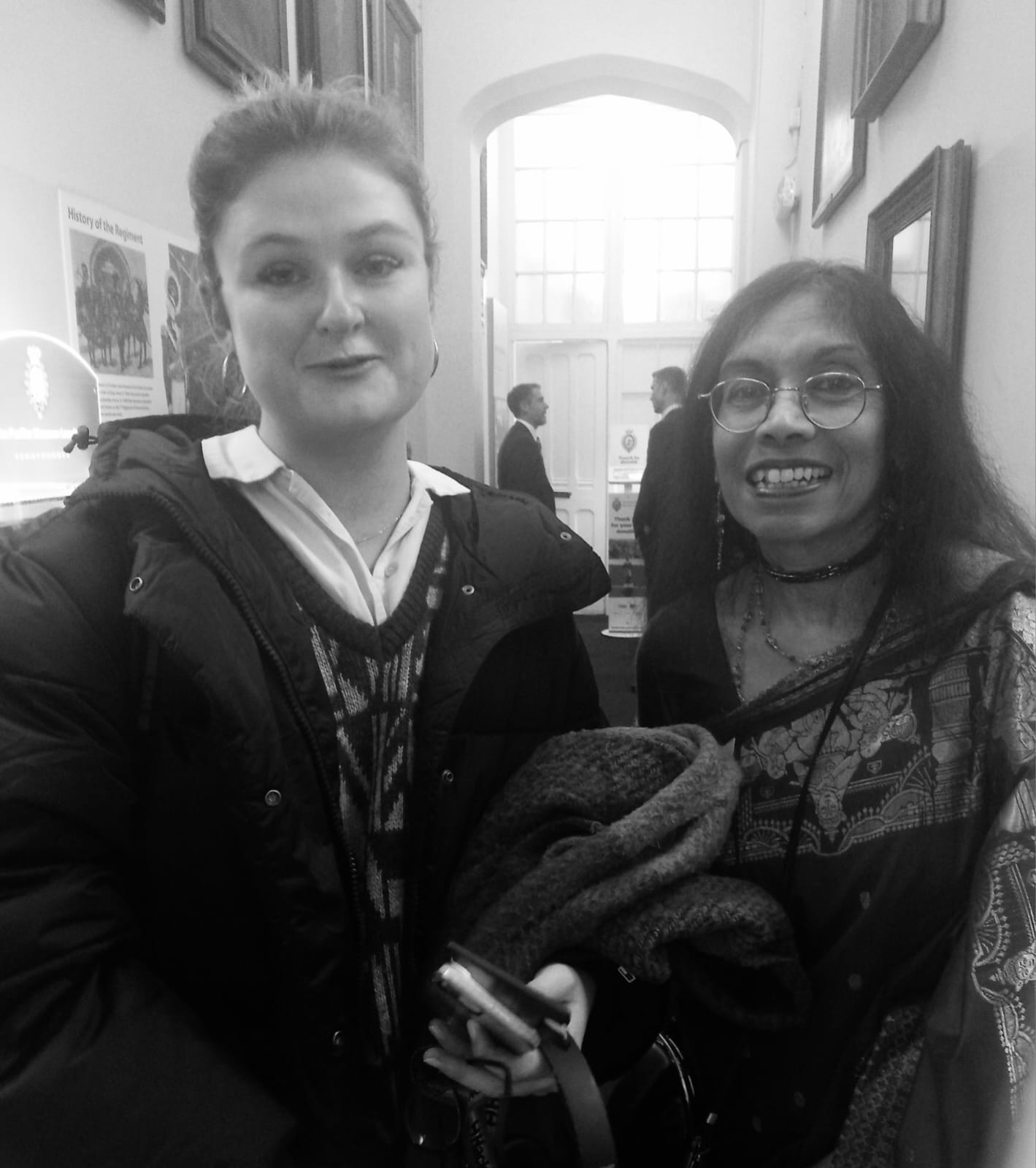
Left: Representing Hackney Borough Council, Ms Helen Davey, one of the officers leading the Heartstone Story Circle programme in the borough.
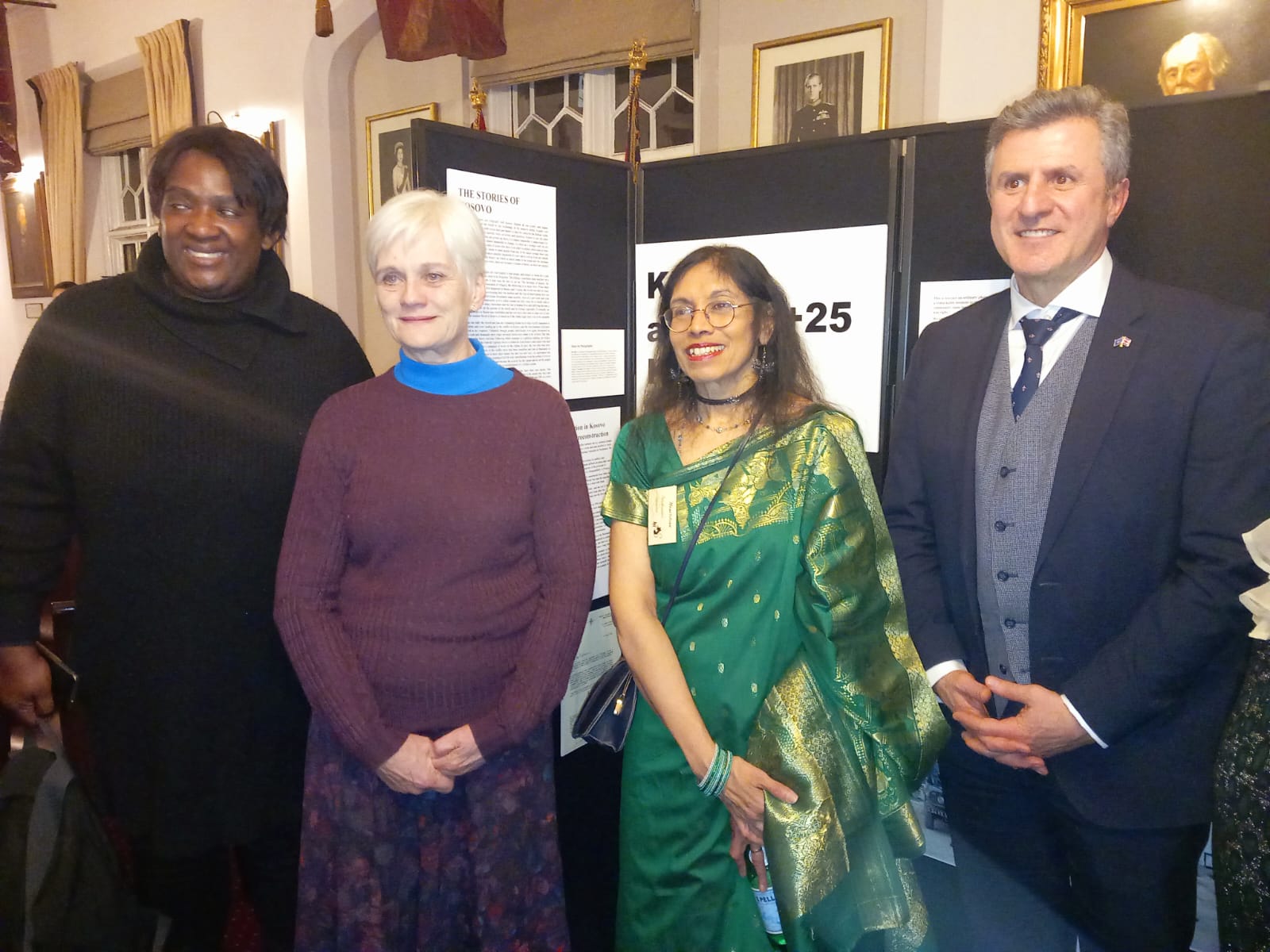 Above left to right: Ms Lorna John, teacher leading one of the Story Circles in Croydon, Ms Penny Smith-Orr – Co-ordinator for the Croydon project and Member of SACRE, Sitakumari, HE Mr Ilir Kapiti – Kosovo Ambassador.
Above left to right: Ms Lorna John, teacher leading one of the Story Circles in Croydon, Ms Penny Smith-Orr – Co-ordinator for the Croydon project and Member of SACRE, Sitakumari, HE Mr Ilir Kapiti – Kosovo Ambassador.
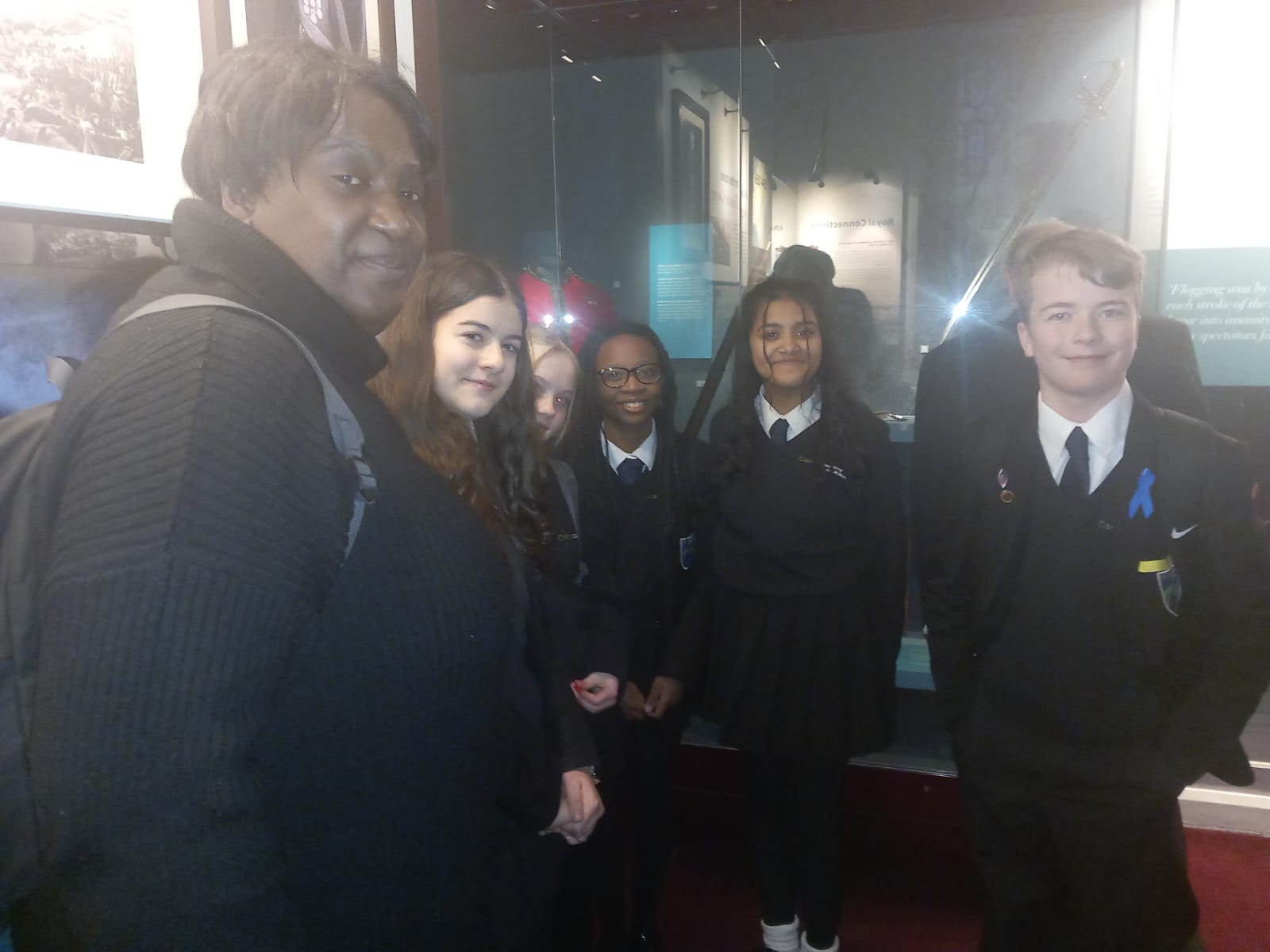 Above: Lorna John with Croydon young people who will now be reaching young people across the UK as guest presenters with Sitakumari in the next online events which will be featuring ‘KFOR and Kosovo +25’.
Above: Lorna John with Croydon young people who will now be reaching young people across the UK as guest presenters with Sitakumari in the next online events which will be featuring ‘KFOR and Kosovo +25’.
 Above from left to right: Cllr Abu Talha Chowdhury for Tower Hamlets, with Cllr Anne-Marie Cousins for Greenwich, Supt Vicky Tunstall – Met Police and General Sir Mike Jackson
Above from left to right: Cllr Abu Talha Chowdhury for Tower Hamlets, with Cllr Anne-Marie Cousins for Greenwich, Supt Vicky Tunstall – Met Police and General Sir Mike Jackson
The Heartstone Team
This event was made possible through the involvement of the Heartstone team, who together with Sitakumari, provide the background to Heartstone for all the guests present.
Jerry Piper, Elena Noel and Nina Rahel are all longstanding friends of Heartstone. Nina Rahel was a founding member, her sister having initiated the very fist Heartstone Story Circle with children in her school over 30 years ago. Nina has assisted with Heartstone projects and exhibitions since that time. Elena Noel helped establish a new phase of Heartstone in London in the early 2000’s bringing funding from the Mayor of London’s office following her initiating Heartstone projects in the London borough of Southwark where she was Co-Chair of Safer Southwark Neighbourhood Board. Jerry Piper, now a co-Director of the Heartstone Confederation of International Story Circles (HCISC), initiated the project on the London Underground, which saw images from Heartstone’s London photodocumentary presented on stations as large-scale installations stretching from Hammersmith in the west to Canada Water in the east. This was during his time as one of the senior managers on Transport for London. All three continue to assist Heartstone actively at all major exhibitions and events in a voluntary capacity.


Above left and right: Mr Jerry Piper, Co-Director Heartstone CISC, and Ms Elena Noel, Hearstone Advisory Council and initiator of the London Heartstone Story Circle project with Mayor of London support, with Mr Leslie Morgan, Deputy Lieutenant for Tower Hamlets.
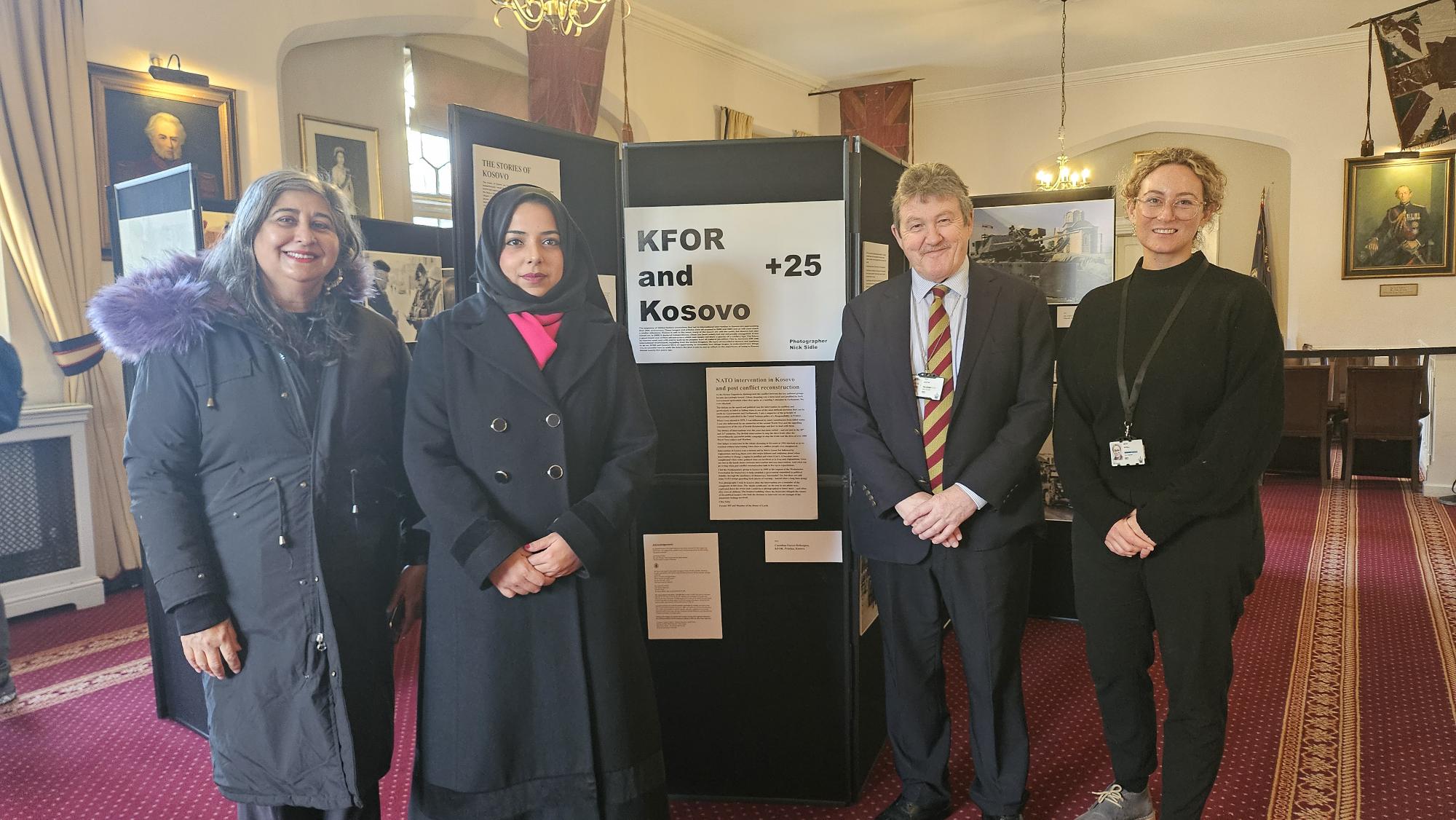
Above: Ms Apsana Begum MP, visited the exhibition and was shown round by Ms Nina Rahel of Heartstone together with Paul Martin for RRF and Beth Wyrill, Curator of the Museum.
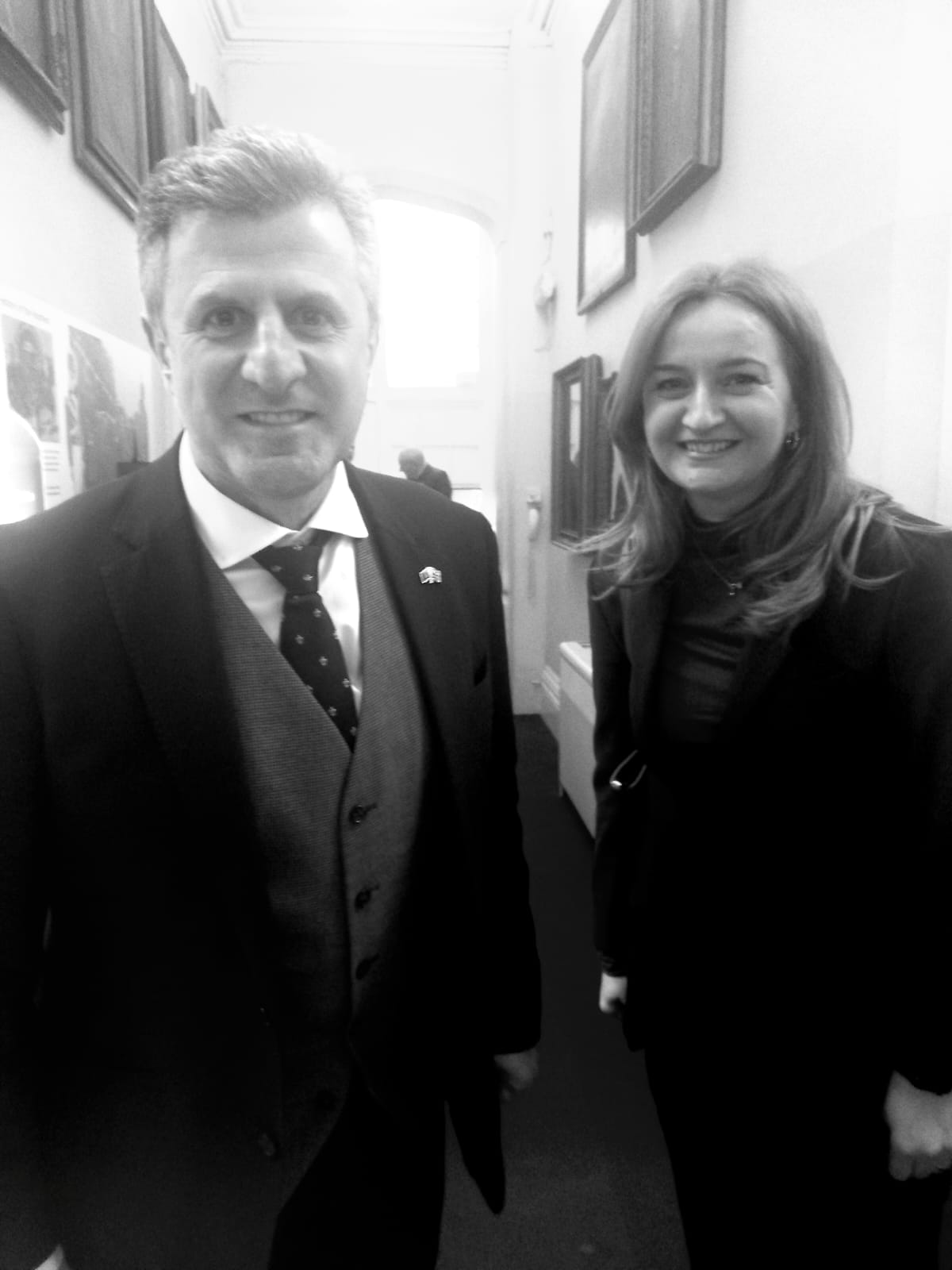
‘KFOR and Kosovo +25’ in Kosovo – the Next Stage
HE The Ambassador for Kosovo, Mr Ilir Kapiti pictured here with the First Secretary – the Ambassador is now assisting with the staging of the ‘KFOR and Kosovo +25’ exhibition in Kosovo, which will be opening at the National Museum of Kosovo on June 11th 2024.
Acknowledgements
Our grateful thanks to the Fusilier Museum (London) for their support and partnership in the staging of this exhibition, in particular the assistance of Major (retd) Mick McCarthy and his staff. The exhibition and the Story Circle project in the London boroughs of Tower Hamlets, Lambeth, Southwark, Croydon and Hackney has been funded by the following sponsors:
Lord Michael Hintze
Mr Leslie Morgan, Deputy Lieutenant for Tower Hamlets
The Worshipful Company of Fletchers
Mayor of London (through MOPAC)
Tower Hamlets Borough Council
Hackney Borough Council
Heartstone business sponsors
Other supporters include:
Ms Apsana Begum, MP and Ms Rushanara Ali, MP.
The United Nations Association – UK (UNA-UK) founded in 1945 is the country’s foremost advocate for UK action at the UN; the UK’s leading source of analysis on the UN; and a vibrant grassroots movement of 20,000 people from all walks of life. We are the only charity in the UK devoted to building support for the UN amongst policymakers, opinion-formers and the public. We have introduced our London colleagues to this exhibition and project.
Interfaith Scotland is the national interfaith organisation for Scotland. We work to help ensure good relations between the diverse religion and belief communities of Scotland and also to share good practice in interfaith dialogue, education, engagement and training nationally and internationally. We have introduced Interfaith Networks across the UK to this exhibition and project, including London.
Regiments featured in the photodocumentary – Royal Regiment of Fusiliers (Tower of London), 1st Queen’s Dragoon Guards (Cardiff Castle), Princess of Wales’ Royal Regiment (Dover Castle), Royal Green Jackets (Winchester RGJ Museum). 45 Commando based in Arbroath.
All photographs in the ‘KFOR and Kosovo +25 exhibition: ©Nick Sidle
Photos of the exhibition and with Cllr Abu Talha Chowdhury:
© Amy Addison-Dunne/Office of the Mayor of Tower Hamlets.

